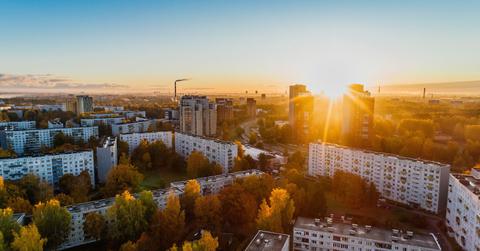Scientists Say Trees In Cities Can Trap As Much Carbon As A Rainforest
New technology has allowed scientists to more accurately estimate how much carbon trees absorb, and the results may change how green spaces in cities are planned.
Updated May 31 2019, 11:33 a.m. ET
Scientists in the United Kingdom at University College London have released a new study that suggests green spaces in cities may be capable of holding the same amount of carbon as rainforests, Metro reports.
Published in Carbon Balance and Management, the study analyzed parts of UCL’s campus in Camden, and north London, which included 85,000 trees.
Using laser pulses, they estimated the amount of carbon absorbed by the trees in the course of their lifetime.
The technique is known as LiDAR (Light Detection and Ranging), and the team used both their own measurements and those collected by the U.K. Environment Agency.
The pulses take a detailed picture of the 3D structure of the trees, which makes the calculations of carbon storage far more accurate.
They found that an area like Hampstead Heath, one of London's most popular green spaces, stores close to 178 tons of carbon for every hectare, or 2.47 acres.
In comparison, rainforests capture about 190 tons of carbon in the same amount of space.
The study's lead author, Dr. Phil Wilkes, says they want the benefits of urban green spaces to be considered from every side.
"Urban trees provide many ecosystem services essential for making cities liveable," he explained.
"This includes providing shade, flood mitigation, filtering air pollution, habitat for birds, mammals and other plants, as well as wider recreational and aesthetic benefits.
Urban trees are a vital resource for our cities that people walk past every day. We were able to map the size and shape of every tree in Camden, from forests in large parks to individual trees in back gardens.
This not only allows us to measure how much carbon is stored in these trees but also assess other important services they provide such as habitat for birds and insects."
It can also be cost-effective for cities, and helps to offset fossil fuel emissions in congested streets with considerable traffic. It's estimated that the value of storing that carbon is about £4.8 million to London every year, or about £17.80 for every tree.
The team hopes that the research will continue, praising the LiDAR system for what it can potentially reveal about how urban trees differ from their more wild counterparts. But ultimately, they hope this study is used to influence city planning.
"An important outcome of our work was to highlight the value of urban trees, in their various and very different settings. The approach has been really successful so far, so we're extending it across London, to other cities in the UK and internationally,” said co-author Dr. Mat Disney.
It's incredible what a nice park in a city can do.
